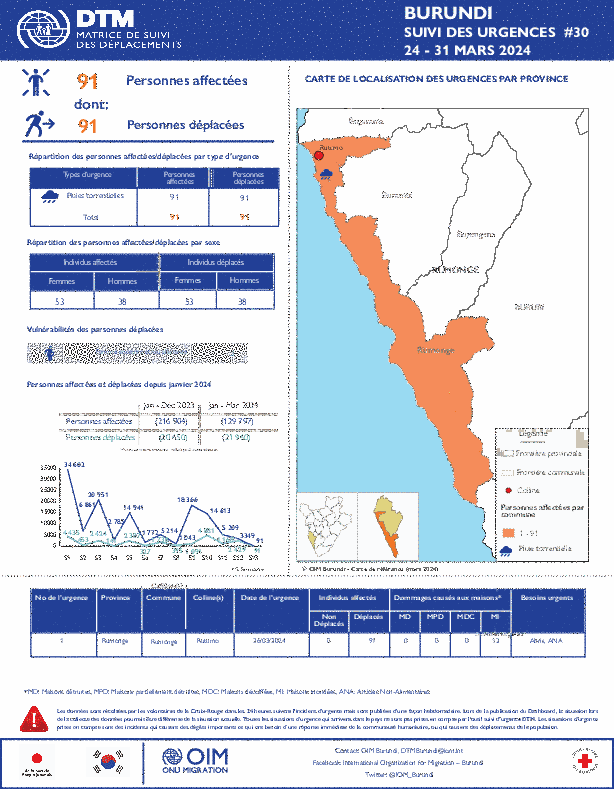-
Countries
-
Data and Analysis
-
Special Focus
-
Crisis Responses
Contact
dtmlebanon@iom.int
Location
Lebanon
Activity
- Mobility Tracking
- Baseline Assessment
Period Covered
Oct 10 2023 -Mar 26 2024
Since October 8 there has been an increase in cross-border incidents between Israel and Lebanon, resulting in the displacement of people both within the South and elsewhere within the country. Since October 10, the Displacement Tracking Matrix (DTM) has been conducting the daily monitoring of population movements. The objective of the exercise is to inform preparedness and response planning.
Population Groups
IDPs
Survey Methodology
Unit of Analysis Or Observation
Admin Area 2
Admin Area 3
Household
Individual
Type of Survey or Assessment
Key Informant
Keywords
Geographical Scope Full Coverage
Administrative boundaries with available data
The current dataset covers the following administrative boundaries
Contact
dtmlebanon@iom.int
Location
Lebanon
Activity
- Mobility Tracking
- Baseline Assessment
Period Covered
Oct 10 2023 -Mar 19 2024
Since October 8 there has been an increase in cross-border incidents between Israel and Lebanon, resulting in the displacement of people both within the South and elsewhere within the country. Since October 10, the Displacement Tracking Matrix (DTM) has been conducting the daily monitoring of population movements. The objective of the exercise is to inform preparedness and response planning.
Population Groups
IDPs
Survey Methodology
Unit of Analysis Or Observation
Admin Area 2
Admin Area 3
Household
Individual
Type of Survey or Assessment
Key Informant
Keywords
Geographical Scope Full Coverage
Administrative boundaries with available data
The current dataset covers the following administrative boundaries
DTM Europe gathers, validates and disseminates information on migrants and refugees travelling through the Mediterranean, Western African Atlantic, and Western Balkan routes to Europe. Key routes include:
- Eastern Mediterranean route (EMR): Bulgaria, Cyprus and Greece
- Central Mediterranean route (CMR): Italy and Malta
- Western Mediterranean route (WMR): Peninsular Coasts of Spain, Balearic Islands, Ceuta and Melilla
- Western African Atlantic route (WAAR): Canary Islands of Spain
DTM also monitors data on migrants in transit through the Western Balkans (WB) region (Albania, Bosnia and Herzegovina, Croatia, Montenegro, North Macedonia, Serbia, Slovenia, Romania, and Kosovo*). These are considered separately to prevent to the extent possible the double counting of the same persons that cross multiple borders to reach Europe.
This report presents the latest available data and trends, focusing on 2023:
- Mixed Migration Flows to Europe
- Migrant Flows Monitoring in the Republic of Türkiye
- First Arrival countries (Italy, Greece, Spain) and other countries of first arrival (Bulgaria, Cyprus and Malta)
- Transits through the Western Balkan region
- Migrants' presence, in Europe and the Republic of Türkiye
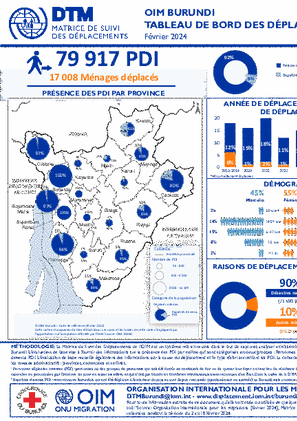
Contact
DTM Burundi, DTMBurundi@iom.int
Language
English
Location
Burundi
Period Covered
Feb 01 2024
Feb 29 2024
Activity
- Mobility Tracking
- Baseline Assessment
La Matrice de Suivi des Déplacements de l’OIM est un système mis en œuvre dans le but de capturer, analyser et disséminer des informations pour mieux comprendre les mouvements et les besoins des personnes déplacées internes (PDI) au Burundi. L'évaluation de base vise à fournir des informations sur la présence des PDI par colline qui sont catégorisés en deux groupes: Personnes déplacées internes (PDI) incluant les PDI retournées dans leur colline d'origine mais pas dans leur maison et les rapatriés devenus PDI. L'évaluation de base recueille également des informations sur la cause du déplacement et le type d'abri accueillant les PDI. La collecte des données est effectuée quatre fois par an par des volontaires formés de la Croix-Rouge du Burundi et opérant à tous les niveaux administratifs: provinces, communes et collines.

Contact
ROPretoriaRMDHub@iom.int
Language
English
Location
Malawi
Period Covered
Feb 01 2024
Feb 29 2024
Activity
- Flow Monitoring
Over the reporting period, a total of 2,754 cross-border movements were observed at the Flow Monitoring Points (FMPs). The average daily number flows was 131. This represented an 2 per cent decrease compared to January, during which 134 individual movements were observed on a daily basis. Mozambique (59%), Malawi (40%), South Africa (<1%) and United Republic of Tanzania (<1%) were the main countries of departure, while Malawi (58%), Mozambique (41%), Zimbabwe (<1%) and South Africa (<1%) were the main countries of intended destination of individuals passing through the different FMPs. Out of 2,754 individuals observed, 65 per cent were males and 35 per cent were females. There were 35 women who were visibly pregnant. Boys and girls (males and females below 18) made up 17 per cent of individuals observed. Of the 467 children observed, 10 were unaccompanied boys and none were unaccompanied girls. However, this information is based on direct observation and self-reporting, and therefore is likely under-reported.
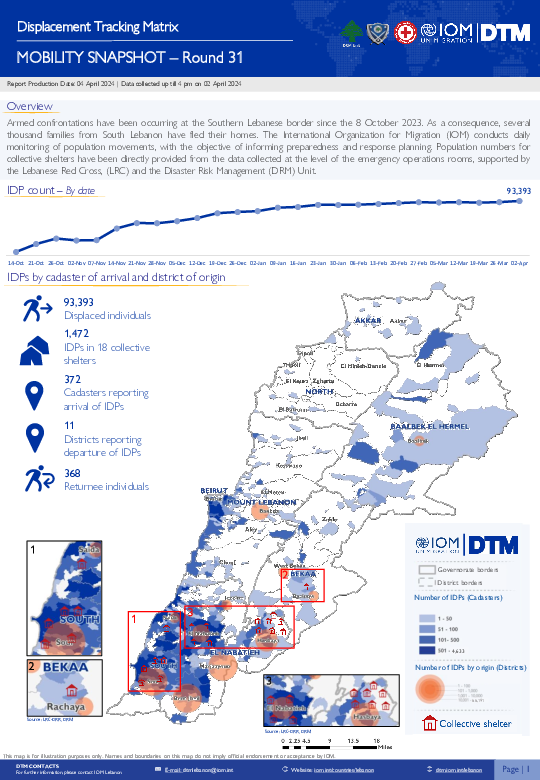
Contact
dtmlebanon@iom.int
Language
English
Location
Lebanon
Period Covered
Oct 10 2023
Apr 02 2024
Activity
- Mobility Tracking
- Baseline Assessment
Since October 8 there has been an increase in cross-border incidents between Israel and Lebanon, resulting in the displacement of people both within the South and elsewhere within the country. Since October 10, the Displacement Tracking Matrix (DTM) has been conducting the daily monitoring of population movements. The objective of the exercise is to inform preparedness and response planning.

Contact
DTM Nigeria, iomnigeriadtm@iom.int
Language
English
Location
Nigeria
Period Covered
Jan 01 2024
Jan 31 2024
Activity
- Flow Monitoring
This report presents the data for January 2024, collected through direct interviews and direct observation by DTM enumerators and triangulated via a network of key informants. It highlights the number of herders and their herds identified at 51 counting points. Notably, this enumeration included areas within the Kachia, Kaura, Kaita, and Faskari Local Government Areas (LGAs) of Kaduna and Katsina states, under the auspices of the UN Peacebuilding Fund. Additionally, it extended to Batsari, Jibia, Kankara, and Dansuma LGAs of Katsina state, which were supported by the European Union Fund.
In January 2024, Transhumance Flow Monitoring tool identified 3,548 herders in Kaduna State and 873 herders in Katsina State. The animal count was estimated at 72,011 for Kaduna State and 21,422 for Katsina State. Notably, 92 per cent of the total number of herders departed from states within Nigeria, while the remaining 8 per cent departed from Niger.
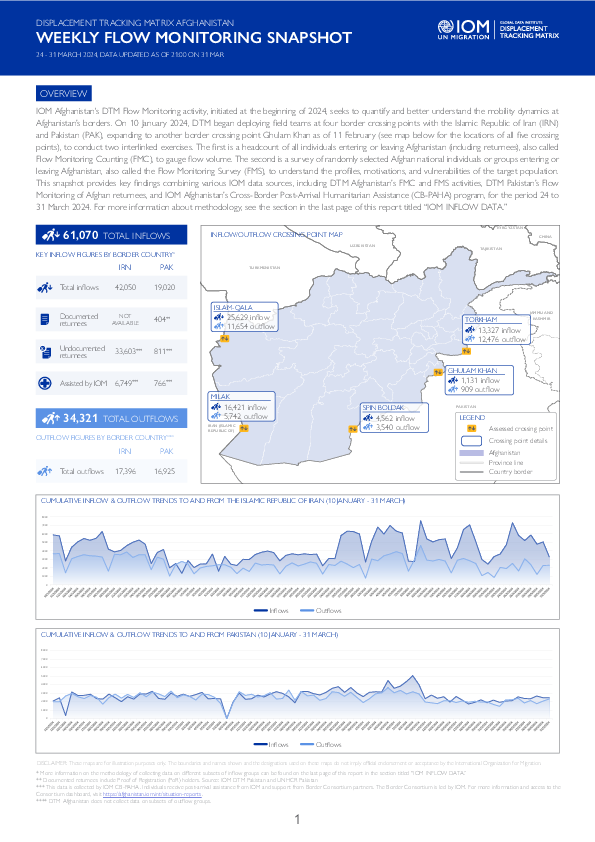
Contact
DTMAfghanistan@iom.int
Language
English
Location
Afghanistan
Period Covered
Mar 24 2024
Mar 31 2024
Activity
- Survey
- Flow Monitoring Survey
- Flow Monitoring
IOM Afghanistan's DTM Flow Monitoring activity, initiated at the beginning of 2024, seeks to quantify and better understand the mobility dynamics at Afghanistan’s borders. On 10 January 2024, DTM began deploying field teams at four border crossing points with the Islamic Republic of Iran (IRN) and Pakistan (PAK), expanding to another border crossing point Ghulam Khan as of 11 February (see map below for the locations of all five crossing points), to conduct two interlinked exercises. The first is a headcount of all individuals entering or leaving Afghanistan (including returnees), also called Flow Monitoring Counting (FMC), to gauge flow volume. The second is a survey of randomly selected Afghan national individuals or groups entering or leaving Afghanistan, also called the Flow Monitoring Survey (FMS), to understand the profiles, motivations, and vulnerabilities of the target population. This snapshot provides key findings combining various IOM data sources, including DTM Afghanistan’s FMC and FMS activities, DTM Pakistan’s Flow Monitoring of Afghan returnees, and IOM Afghanistan’s Cross-Border Post-Arrival Humanitarian Assistance (CB-PAHA) program, for the period 24 to 31 March 2024. For more information about methodology, see the section in the last page of this report titled “IOM INFLOW DATA.”
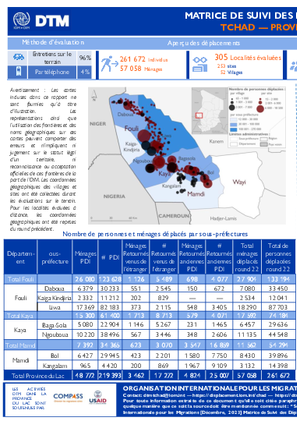
Contact
DTM Tchad, dtmtchad@iom.int
Language
French
Location
Chad
Period Covered
Dec 22 2023
Jan 24 2024
Activity
- Mobility Tracking
- Site Assessment
- Baseline Assessment
Depuis 2015, le Tchad fait l’objet d’attaques perpétrées par des groupes armés non-étatiques présents dans le bassin du Lac Tchad engendrant des déplacements massifs de populations, aussi bien internes que transfrontaliers. Au Tchad, l’OIM met en œuvre sa Matrice de suivi des déplacements (DTM, Displacement Tracking Matrix en anglais) dans la province du Lac depuis mai 2015 pour mesurer l’évolution du nombre, des profils et les besoins des populations déplacées à la suite de cette crise, afin de mieux orienter les programmes humanitaires et de développement. Les données sont collectées à travers des entretiens avec des informateurs clés (autorités locales, chefs traditionnels, représentants des personnes déplacées et gestionnaires de sites) dans les villages et sites d’accueil des personnes déplacées, ainsi que par des observations directes dans ces localités.
Ce tableau de bord présente les résultats des évaluations menées entre le 22 décembre 2023 et le 24 janvier 2024 dans 305 lieux de déplacement. Le Round 22 a enregistré une augmentation globale de 8 pour cent en termes de total de population déplacée par rapport au Round 21 dont 3 pour cent sur des sites existants, principalement dans les sous-préfectures de Liwa et Daboua, et 5 pour cent dus à des déplacements vers de nouveaux sites. Les principales raisons de l'augmentation de la population déplacée observée dans les lieux de déplacement évalués sont l'insécurité, qui se traduit principalement par des déplacements préventifs, les inondations de décembre 2023 et le retour de certaines personnes déplacées vers les zones d'agriculture et de pêche. La situation de déplacement dans la province du Lac reste volatile, avec la création de nouveaux sites de déplacement spontanés et l'abandon de certains sites existants. Cette collecte de données a été réalisée en partenariat avec la Commission Nationale d'Accueil et de Réinsertion des Réfugiés et Rapatriées (CNARR), le gouvernorat, l’Institut National de la Statistique, des Etudes Economiques et Démographiques (INSEED), le Ministère de l’Economie, du Plan et de la Coopération Internationale (MEPCI), le Comité Provincial d’Action (CPA) et l'Association pour l'Action Humanitaire et le Développement Durable (ACHDR). Les données ont été triangulées par la DTM et les acteurs humanitaires ont été impliqués dans l'analyse approfondie des données.

